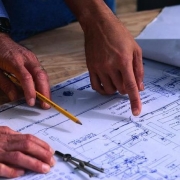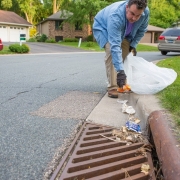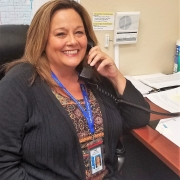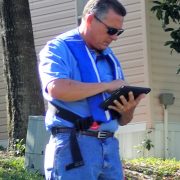
Frequently Asked Questions
There are a variety of options and techniques property owners can use to help reduce or eliminate nuisance iguana issues. There are several ways property owners can make the area less appealing. Many of these strategies are very simple and easily employed. This list of frequently asked questions was compiled from the Florida Fish and Wildlife Conservation Commission’s website www.myfwc.com/iguana.
Does LWDD provide eradication services for iguana infestations?
LWDD is a single purpose special district with the authority to provide flood control and water supply to the residents within its boundary. Tax assessments are collected for the maintenance and operation of these facilities. Iguanas typically do not interfere with LWDD’s flood control operations. However, where iguana activity is threatening significant damage to drainage infrastructure, LWDD may contract with professional wildlife managers to help control populations.
What might be attracting the iguanas to my property?
Understanding why iguanas may be attracted to an area is the first step to prevention. Typically, iguanas will use an area for foraging or for nesting. To prevent iguanas from entering your property consider what might attract them. Never feed iguanas – either intentionally or unintentionally. Food left outdoors will attract iguanas and can create problems for both you and your neighbors by creating dense concentrations of iguanas. Pans of cut fruit and outside pet food will attract iguanas as well as other unwanted visitors like rats and raccoons.
How can I prevent the iguanas from nesting?
You can remove protective covers including dense thickets, brush or rock piles where iguanas congregate. Fill vacant iguana burrows with sand during the day when the animals are likely to be outside of the burrow. You do not want to fill these holes with any animals still inside.
Contrarily, some property owners have constructed artificial nesting habitats to attract iguanas. The purpose of this approach is to control reproduction. Iguanas lay their eggs in sand or mulch. By adding mulch piles or sand piles near sea walls, you can encourage iguanas to focus nesting in these controlled structures. Once eggs are deposited, they can be easily removed then disposed of in a sealed plastic bag.
What type of landscape material can I plant to deter the iguanas?
Iguanas prefer to eat some very popular landscaping material such as Hibiscus, Orchids, Roses, Nasturtiums, Impatiens and Purple Heart Plant. Iguanas prefer bright red, orange or yellow flowers and fruits and feed on tender leaves. Instead, plant species that are iguana-resistant, such as Milkweed, Pentas, and Citrus. Generally, plants with thick, tough or waxy leaves will discourage iguana consumption. These types of leaves are less palatable and often difficult to digest. If the food source is removed, iguanas will be less likely to inhabit an area.
What types of exclusion techniques can I use?
Exclusion techniques can also be deployed to keep iguanas from damaging your property. Consider protecting valuable plants with cages or screen enclosures. Iguanas are excellent climbers. They may get into and on dwellings via overhanging trees. Trim overhanging branches to remove the unintentional “bridge” to buildings. Sheet metal guards on trees, palms, and dock pilings can prevent them from climbing.
Wire barriers can prevent digging on your property. In areas where iguanas burrow or dig, consider installing chicken wire fencing. This fencing should be buried several inches underground or the iguanas may dig underneath the fence.
What types of deterrent techniques can I use?
Several options can help you deter iguanas from your property. Property owners can surprise iguanas by spraying them with a water hose until they leave the area. You can also make loud noises to startle iguanas and create an unwelcome atmosphere around your property. Other techniques include hanging CD-ROM discs near sea walls or on trees or other plants you want to protect. However, you will need to change the position of CDs on a weekly basis, so the iguanas do not become accustomed to their light reflections.
Is there an iguana repellent I can use?
While not proven, some property owners have experienced success with iguana repellents. A homemade spray repellent can be made using garlic, lime juice, habanero pepper, and dish soap. Iguanas loathe the smell of these ingredients and for the most part, try to avoid the areas and any kind of food source that contains the smell of these ingredients. Using iguana repellents requires the need to redo the application each time it rains as the repellent will be washed away.
Where can I get professional help?
Residents are encouraged to seek professionals to remove iguanas from their property. Property owners can search the internet or phone book to locate wildlife control companies. Costs can vary depending on the extent of iguana infestation and the species of iguana that has invaded your property. Be sure to get a written quote from several service providers before contracting with a provider.
Can I kill the iguanas on my property?
Iguanas and all other wildlife are protected by anticruelty laws, and inhumane treatment of them is prohibited and punishable by state law. Inhumane treatment includes the use of poisons to kill iguanas; no poisons are legal to use on iguanas or any other reptile in Florida. Property owners that desire to kill the iguanas themselves must do so safely and humanely by stabbing or shooting them directly in the brain or decapitating them without having them suffer. However, it is recommended homeowners contact their local law enforcement to inquire about regulation regarding the discharge of a firearm in their area.
Can a property owner or a professional service provider enter LWDD’s canal right-of-way to trap or provide iguana eradication services?
Prior to working on LWDD’s right-of-way authorization is required. Property owners and/or professional service providers should contact LWDD for authorization at 561-498-5363 or info@lwdd.net.
Where can I find more information on iguana control?
Visit the Florida Fish and Wildlife Conservation Commission website at www.myfwc.com/iguana.








